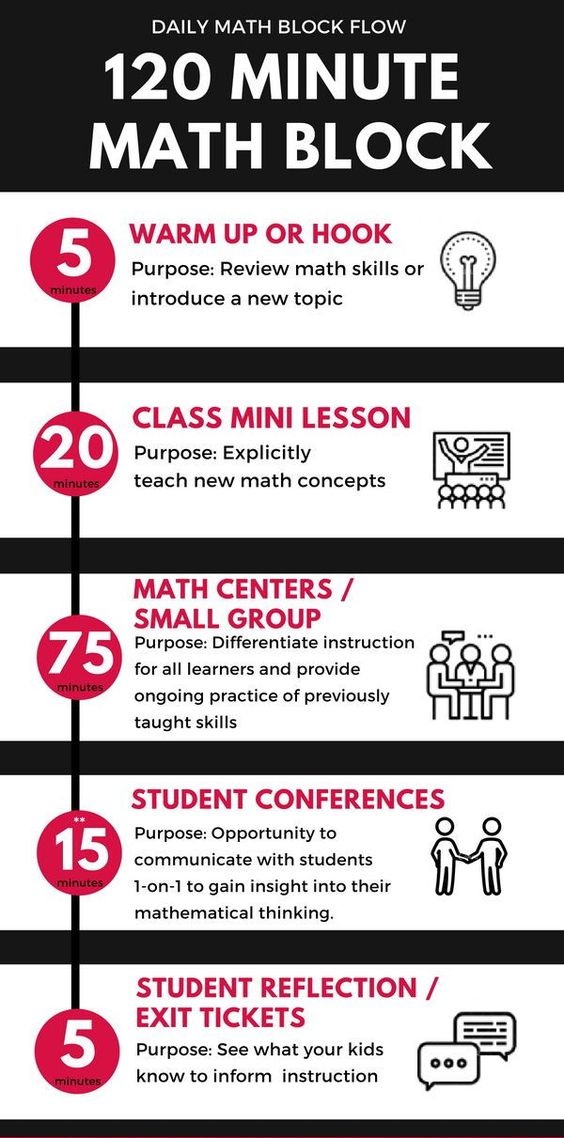Depending on how much time you have for guided math, find ideas on how to schedule your daily math block to include key components for success.
Ever wonder what your daily math block should look like?
A well designed math block incorporates whole group and small group instruction. It also provides time for teaching new skills, practicing for mastery and reviewing previously taught skills.
However, there are two things I want you to keep in mind. The ideal and the real. And I’m going to share both.
First, let me share what an ideal elementary math block looks like. When I say ideal, I’m talking about a math block that is 75 minutes or longer.
Warm Up Activity For Books
Purpose: (1) Review math skills or (2) Introduce a new topic
Any good lesson starts out with an engaging opening. Math is no exception.
This section of your math block should be fast paced. This is either the time for a quick review or a way to interest your kids in a brand new topic. Remember, you want to spend the bulk of your time in centers so that you can work with your teacher led small group.
Here are some examples of things you can do during your warm up:
• Number Talks
• Calendar Activities
• Problem of the Day
• Number of the Day
• Kinesthetic Math Activities
• Number Sense Routines
Whole Class Mini-Lesson
This is the part of your daily math block when you are teaching a mini-lesson. You’re teaching and modeling new concepts by using think-alouds and clear visual models.
It’s also the time to do guided practice. Set aside a short amount time for students to actually practice what you’re modeling. This can look many different ways: interactive large group activities, partner work, etc.
Be strategic. Stay focused on the topic. Otherwise you may find yourself going down a rabbit hole and then not having enough time for math centers.
Here are some examples of things you can do during your whole group mini-lesson:
• Math Read-Aloud
• Hands-On Activities with Manipulatives
• Partner Work
• Group Activities
Teacher Tip – Since this is a “mini-lesson” after you explicitly model you may not get to guided practice on the same day. That’s OK! You can do guided practice the next day. The important part is to make sure you are modeling AND then providing support.
Math Centers and Teacher Led Small Group
Purpose: (1) Differentiate instruction for all learners and (2) provide ongoing practice and review of previously taught skills
There are 2 different things going on during this portion of your math block.
Math Centers – Students practice and review math skills in small groups or pairs, without teacher support (You’ll be at working with your small group).
Examples of math centers can include:
• Math Games
• Journals
• Task Cards
• Fluency Activities
• Problem Solving Tasks
• Math Sorts
Teacher Lead Small Group – This is my favorite part of the block! While the rest of your class is working in centers, you’re targeting instruction with a small group of your students in order to meet their needs.
It’s that magic time of the math block because you get to see and correct misconceptions up close. This is where you get to move your students.
You’re finished with your last teacher led small group and the rest of your students are cleaning up their stations.
Now, what?
It’s time for your kids to show what they know. Let’s move to the last part of an ideal daily math block. Time to assess.
Student Reflection
Purpose: (1) See what your kids know and (2) Inform instruction
This is the time to do a quick check of the day’s learning. It’s not a formal test.
What about if you only have 45 minutes?
This definitely isn’t ideal. But let’s keep it real, I know that some of you only have 45 minutes. The first thing, I strongly suggest that you advocate for more time for math.
With that out the way let’s get real creative.
In this scenario, I suggest keeping both the warm up and the reflection time 5 minutes each. This will leave you with 35 minutes each day for alternating teaching a whole group lesson OR doing math centers. See example below:
Monday: Warm Up (5 min.) – Whole Group (35 min.) – Reflection (5 min.)
Tuesday: Warm Up (5 min.) – Math Centers (35 min./2 groups) – Reflection (5 min.)
Then continue the pattern for the other days of the week.
